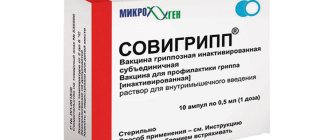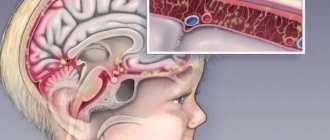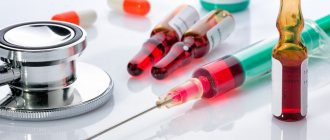Vaccination against rabies
In accordance with the Fundamentals of the legislation of the Russian Federation on the protection of the health of citizens (Article 33), “A citizen or his legal representative has the right to refuse medical intervention or demand its termination...”
In accordance with the Federal Law of September 17, 1998 N 157-FZ “On Immunoprophylaxis of Infectious Diseases” Article 5. Rights and responsibilities of citizens in the implementation of immunization:
1. When carrying out immunoprophylaxis, citizens have the right to:
...refusal from preventive vaccinations.
2. Lack of preventive vaccinations entails:
- a ban on citizens traveling to countries where, in accordance with international health regulations or international treaties of the Russian Federation, their stay requires specific preventive vaccinations;
- temporary refusal to admit citizens to educational and health institutions in the event of widespread infectious diseases or the threat of epidemics;
- refusal to hire citizens for work or removal of citizens from work, the performance of which is associated with a high risk of contracting infectious diseases.
Decree of the Government of the Russian Federation dated July 15, 1999 N 825 approved a list of works, the implementation of which is associated with a high risk of contracting infectious diseases and requires mandatory preventive vaccinations:
1. Agricultural, drainage, construction and other work on excavation and movement of soil, procurement, fishing, geological, survey, expedition, deratization and disinfestation work in areas unfavorable for infections common to humans and animals.
2. Work on logging, clearing and improvement of forests, health and recreation areas for the population in areas unfavorable for infections common to humans and animals.
3. Work in organizations for the procurement, storage, processing of raw materials and livestock products obtained from farms affected by infections common to humans and animals.
4. Work on the procurement, storage and processing of agricultural products in areas unfavorable for infections common to humans and animals.
5. Work on the slaughter of livestock suffering from infections common to humans and animals, the procurement and processing of meat and meat products obtained from it.
6. Work related to the care of animals and maintenance of livestock facilities in livestock farms that are vulnerable to infections common to humans and animals.
7. Work on catching and keeping stray animals.
8. Maintenance work on sewerage structures, equipment and networks.
9. Work with patients with infectious diseases.
10. Work with live cultures of pathogens of infectious diseases.
11. Work with human blood and biological fluids.
12. Work in all types and types of educational institutions.
Thus, if the profession is related to the need for preventive (pre-exposure) vaccination against rabies, then the person has the right to refuse vaccination, but then does not have the right to work in this profession.
Rabies vaccine
Rabies vaccine (rabies vaccination) is administered to the patient after being bitten by an animal or person who has been diagnosed or suspected of being infected with the rabies virus (rabies). And also in cases of open contact (without a bite) of a healthy person with the saliva of a rabies patient.
The rabies vaccine does not kill the virus, but causes the host body to produce a specific antigen for the infection. The vaccine allows a person to acquire active immunity to the virus for a year or more.
Contraindications
Any medicine has restrictions on its use, and rabies vaccines for humans are no exception.
The main ones include the following:
- Individual intolerance to individual components of the product;
- Any infectious diseases in the acute phase;
- Severe chronic diseases, especially in the stage of decompensation;
- The presence of severe forms of allergic reactions or pronounced manifestations of allergies during previous vaccinations with anti-rabies serum;
- Pregnancy and lactation period.
In emergency cases of vaccination, contraindications are not taken into account.
Side effects:
The administration of serum can be accompanied by both local manifestations and have a negative effect on the entire body.
Local reactions appear:
- Local redness;
- Itching;
- Local edema and hyperthermia;
- In rare cases, enlargement of regional lymph nodes is observed.
General manifestations:
- Symptoms of intoxication (dizziness and headache, weakness);
- Temperature increase;
- Dyspeptic symptoms (nausea, diarrhea, vomiting);
- Neurological manifestations are rarely observed.
special instructions
The rabies vaccine must be administered in a medical institution by qualified medical personnel. After the injection is given, the patient must be under the supervision of a doctor or nurse for at least 30 minutes. If any of the above-mentioned side effects occur, you must immediately take antihistamines and antisensitizing medications. If a neurological symptom complex manifests itself, urgent hospitalization is necessary.
In any medical office where the procedure is carried out, there must be an anti-shock first aid kit to provide first aid in case of shock. All vaccinated people are given a special certificate indicating the type and serial number of the vaccine and the course of use of the drug.
When undergoing a course of treatment with an anti-rabies vaccine, it is necessary to completely avoid drinking alcoholic beverages for six months. Try to avoid hypothermia, overwork, prolonged exposure to the sun, and stress factors.
Consequences of ignoring doctors' recommendations
The duration of the effect of any vaccine on health and the body is a 10-day period. In the process of exposure to such solutions, there is a possibility of any side effects. Traditionally, the consequences are as follows:
- gastric problems (nausea, vomiting, diarrhea, flatulence, pain),
- allergic reactions (rash, swelling, itching, hyperemia),
- headache and dizziness, migraine and other manifestations of weakness;
- apathy, drowsiness, increased aggressiveness and other mental disorders and abnormalities.
If a patient begins to combine rabies injections and alcohol, he risks experiencing increased symptoms of this phenomenon. Thus, an exacerbation of any chronic diseases may occur, and general weakness and malaise may appear. Or, conversely, alcoholic drinks will mask the dangerous manifestations of the disease and will interfere with timely diagnosis and treatment.
Stages of disease development
In the first stage, infection occurs. Viruses almost always enter the body through bites. Immediately after this, the incubation period begins. It has been noted that the closer the open wound is to the brain, the less incubation there will be and the disease will pass faster.
Next comes the first stage of the disease. The main symptoms are:
- weakness;
- headache;
- dry mouth.
A person does not immediately understand that this is rabies, since the signs are similar to an alcohol hangover, fatigue or a common cold. At this time, it is forbidden to treat the wound with alcohol or drink alcohol, as the drink will only speed up the spread of the virus. The stage can last up to 3 days, ending with auditory or visual hallucinations.
After which the next stage begins - excitement, which also takes 3 days. The most important symptom is considered to be a fear of water in any of its manifestations: drinking, ponds, etc. Severe spasms and pain are observed in the throat. After the period expires, foam comes out of the mouth, the patient shows aggression and begins to rush at others.
The last stage ends with paralysis and death. The person becomes indifferent to everything, and the body temperature can rise to +42ºС. The body experiences destruction of the protein mass, which causes paralysis of the limbs, and then the respiratory tract and heart.
The duration of the disease from the moment of bite to death is approximately 1 week. Therefore, it is very important to immediately undergo a course of therapy and under no circumstances drink alcohol.
How does alcohol interact with rabies vaccinations?
It is absolutely forbidden to drink alcohol before you are going to get the vaccine, and after the procedure . The fact is that during illness or infection, a pathogenic microorganism enters the human body. As a result of the fact that there are very few foreign bodies and the infection is weakened, the body easily copes with rabies. After which, antibodies to possible future infection remain in the cells and internal systems.
Rabies vaccination is contraindicated in cases where the immune system is weakened. The cause of a weak immune system may be:
- immunosuppressants – medications that forcibly reduce the body’s immune response; are prescribed in order not to cause rejection of foreign bodies during and after surgery, as well as in the treatment of diseases, the outcome of which can greatly affect the functioning of the immune system;
- severe illnesses that weaken the immune system due to the high stress load on the body;
- alcohol consumption, which has a strong effect on the immune system, reducing protective barriers; The danger is great even with a one-time intake of alcoholic beverages.
Due to decreased immunity, the rate of spread of viruses begins to instantly increase. If you drink alcohol after being vaccinated, a weak body may not be able to cope with the pathogens.
Types of bites
As a result of an attack by a dog (as well as other animals), both superficial and lacerated bites can occur.
With a superficial bite, the dog only pierces the skin with its teeth, and a puncture wound appears.
With a lacerated dog bite, not only more serious damage is observed, but also greater blood loss.
Most often, the dog tries to bite the following parts of the body: forearms, palms, thighs and ankles. When bitten by dogs, in addition to wounds and scratches, damage to tendons, blood vessels and nerves may occur.
Children's shoulders and face may be injured when attacked by “four-legged friends.” But it is especially dangerous when a dog bite hits the head or neck area. This can lead to internal bleeding, open and depressed skull fractures, and in some cases, death.
Symptoms of a dog bite
The main symptoms of a bite are bleeding and pain. If therapeutic measures are not taken, the wound may become infected.
Pay attention to the following signs of infection:
- increased body temperature;
- swollen lymph nodes;
- attacks of fever;
- swelling of the wound, pain and burning sensation in it.
The consequences of a bite from a dog, as well as from a cat and other animals, can be rabies and tetanus. Therefore, it is important to immediately seek help from a traumatologist at the nearest emergency room.
The contents of the vaccine ampoule must be dissolved in 1.0 ml of water for injection. Dissolution time should not exceed 5 minutes. The dissolved vaccine is a clear or slightly opalescent liquid from colorless to light yellow. Storage of the dissolved vaccine for more than 5 minutes is not allowed.
The dissolved vaccine is injected slowly intramuscularly into the deltoid muscle of the shoulder, for children under 5 years old - into the upper part of the anterolateral surface of the thigh.
Injection of the vaccine into the gluteal region is not allowed.
Providing anti-rabies assistance
Anti-rabies care consists of local treatment of wounds, scratches, abrasions, salivation sites and the subsequent administration of the COKAV rabies vaccine or, if indicated, the combined administration of rabies immunoglobulin (RAI) and the COKAV rabies vaccine. The interval between the administration of AIH and COCAV is no more than 30 minutes.
Local wound treatment
Local treatment of wounds (bites, scratches, abrasions) and drooling areas should begin immediately or as soon as possible after a bite or injury. It consists of abundantly washing the wound surface for several minutes (up to 15 minutes) with water and soap or another detergent (detergent), or, in the absence of soap or detergent, the injury site is washed with a stream of water. After this, the edges of the wound should be treated with 70% ethyl alcohol or a 5% alcohol solution of iodine.
Sutures should be avoided whenever possible.
Suturing is indicated only in the following cases:
- for extensive wounds - several guiding skin sutures after pre-treatment of the wound;
- for cosmetic reasons (skin sutures on facial wounds);
- suturing of bleeding vessels in order to stop external bleeding.
If there are indications for the use of rabies immunoglobulin, it is used immediately before suturing (see section Dose of rabies immunoglobulin (RAI))
After local treatment of wounds (damages), therapeutic and prophylactic immunization is immediately started.
Therapeutic and preventive immunization
A detailed scheme of therapeutic and prophylactic immunization and notes to the scheme are presented below in the “Scheme of therapeutic and prophylactic vaccinations with the vaccine for the prevention of rabies COCAV and rabies immunoglobulin (RAI)”.
All persons at risk of contracting rabies are subject to therapeutic and prophylactic immunization. If there are indications for combination treatment, then AIH is first administered and, no more than 30 minutes later, COKAV is administered after it.
Rabies immunoglobulin (RAI) is prescribed as soon as possible after contact with a rabid or suspected rabid animal, wild or unknown animal.
Before administering heterologous (horse) rabies immunoglobulin, it is necessary to check the patient’s individual sensitivity to horse proteins (see “Instructions for the use of rabies immunoglobulin from liquid horse blood serum”). Heterologous rabies immunoglobulin is administered no later than 3 days after the bite.
Before administering homologous (human) rabies immunoglobulin, individual sensitivity is not tested. Homologous anti-rabies immunoglobulin is administered no later than 7 days after the bite.
Dose of rabies immunoglobulin (RAI). Heterologous (horse) rabies immunoglobulin is prescribed at a dose of 40 IU per 1 kg of body weight. The volume of administered heterologous rabies immunoglobulin should not exceed 20 ml. Homologous (human) rabies immunoglobulin is prescribed at a dose of 20 IU per 1 kg of body weight.
Introduction of AIG. As much of the recommended dose of AIH as possible should be infiltrated into the tissue around the wound and deep into the wound. The unused portion of the drug dose is injected deep intramuscularly into a site other than the rabies vaccine.





